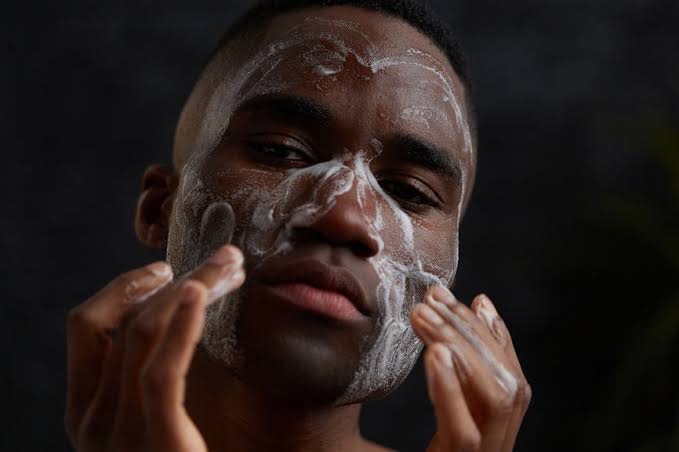Men with dark skin often face unique skincare challenges, including hyperpigmentation, dryness, and sensitivity to certain products. A dedicated skincare routine can help address these issues, promoting a healthy, even-toned complexion. Here’s a comprehensive skincare routine tailored for dark skin men.
Morning Routine
1. Cleansing

Start your day with a gentle, hydrating cleanser to remove overnight impurities and excess oil without stripping your skin of its natural moisture. Choose a sulfate-free formula that suits your skin type (dry, oily, combination, or sensitive).
Recommended Product Types:
– Hydrating gel cleansers
– Cream cleansers
2. Toning
A good toner helps to balance your skin’s pH, remove any leftover impurities, and prepare your skin for better absorption of subsequent products. Look for alcohol-free toners with soothing and hydrating ingredients like witch hazel, rose water, or hyaluronic acid.
Recommended Product Types:
– Alcohol-free toners
– Hydrating mists
3. Serum

Apply a serum that targets specific skin concerns such as hyperpigmentation, dullness, or uneven skin tone. Serums containing vitamin C, niacinamide, or hyaluronic acid are excellent choices for brightening and hydrating the skin.
Recommended Ingredients:
– Vitamin C
– Niacinamide
– Hyaluronic acid
4. Moisturizing

Hydration is key for maintaining healthy skin. Opt for a lightweight, non-comedogenic moisturizer that hydrates without clogging pores. Ingredients like glycerin, hyaluronic acid, and ceramides are beneficial.
Recommended Product Types:
– Gel moisturizers
– Lightweight lotions
5. Sun Protection

Sunscreen is essential for all skin tones. Choose a broad-spectrum sunscreen with at least SPF 30. Mineral sunscreens with zinc oxide or titanium dioxide are less likely to leave a white cast on dark skin.
Recommended Product Types:
• Broad-spectrum SPF 30+ sunscreens
• Tinted sunscreens (to avoid white cast)
Evening Routine
1. Double Cleansing
Start with an oil-based cleanser to remove makeup, sunscreen, and impurities, followed by a water-based cleanser to clean the skin thoroughly.
Recommended Product Types:
• Cleansing oils or balms
• Gentle foaming cleansers
2. Exfoliating
Exfoliation helps remove dead skin cells and promote cell turnover. Use a chemical exfoliant containing AHAs (like glycolic acid) or BHAs (like salicylic acid) 2-3 times a week, depending on your skin’s tolerance.
Recommended Product Types:
• Glycolic acid exfoliants
• Salicylic acid exfoliants
3. Toning
Apply your toner to prepare the skin for better absorption of subsequent products.
Recommended Product Types:
• Alcohol-free toners
• Hydrating mists
4. Treatment
Incorporate treatments that address specific concerns such as hyperpigmentation, acne, or fine lines. Products with ingredients like retinol, alpha arbutin, and licorice extract can be effective.
Recommended Ingredients:
– Retinol
– Alpha arbutin
– Licorice extract
5. Moisturizing
Use a richer moisturizer at night to repair and hydrate your skin as you sleep. Look for products with ingredients like shea butter, ceramides, and peptides.
Recommended Product Types:
• Cream moisturizers
• Overnight masks
Additional Tips
1. Masking
Use a hydrating or brightening mask once or twice a week to give your skin an extra boost. Look for masks with ingredients like hyaluronic acid, vitamin C, and antioxidants.
2. Spot Treatment
For dark spots or hyperpigmentation, use a targeted spot treatment with ingredients like hydroquinone, kojic acid, or azelaic acid.
3. Healthy Lifestyle
Maintain a balanced diet rich in fruits, vegetables, and omega-3 fatty acids. Stay hydrated by drinking plenty of water, and ensure you get adequate sleep to help your skin repair and regenerate.
4. Regular Check-ups
Visit a dermatologist regularly to address any persistent skin concerns and to get personalized skincare advice.
A tailored skincare routine can help address the unique needs of dark skin, promoting a healthy, even-toned complexion. By focusing on gentle cleansing, hydration, sun protection, and targeted treatments, you can effectively manage common concerns like hyperpigmentation and maintain beautiful, glowing skin. Consistency is key, and it’s important to listen to your skin’s needs and adjust your routine as necessary.